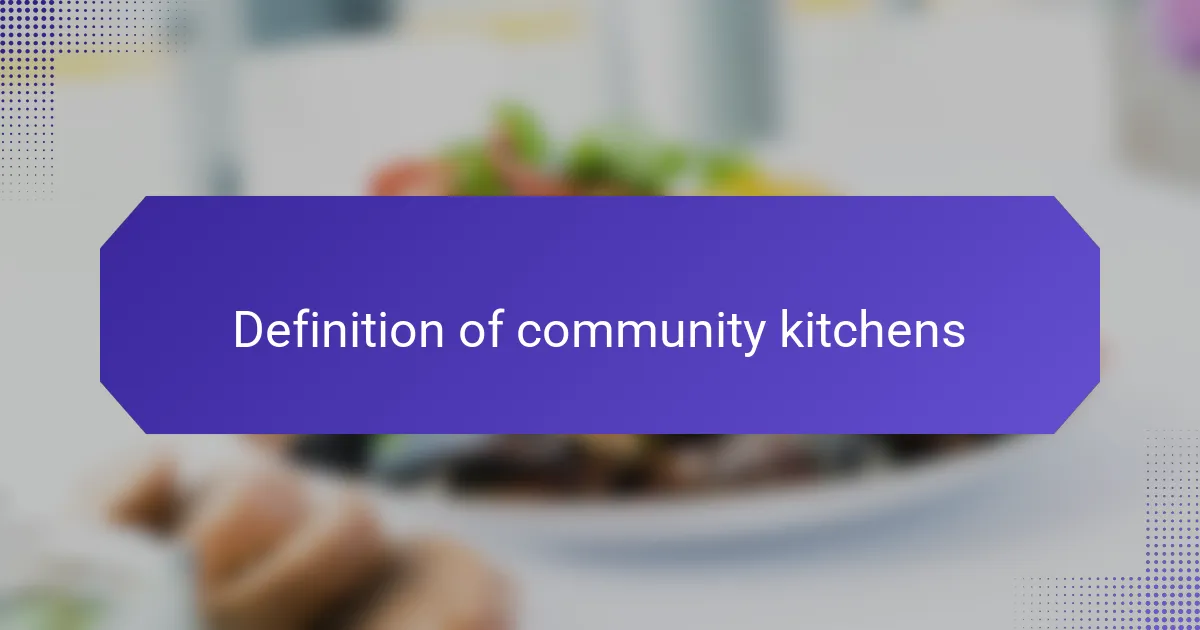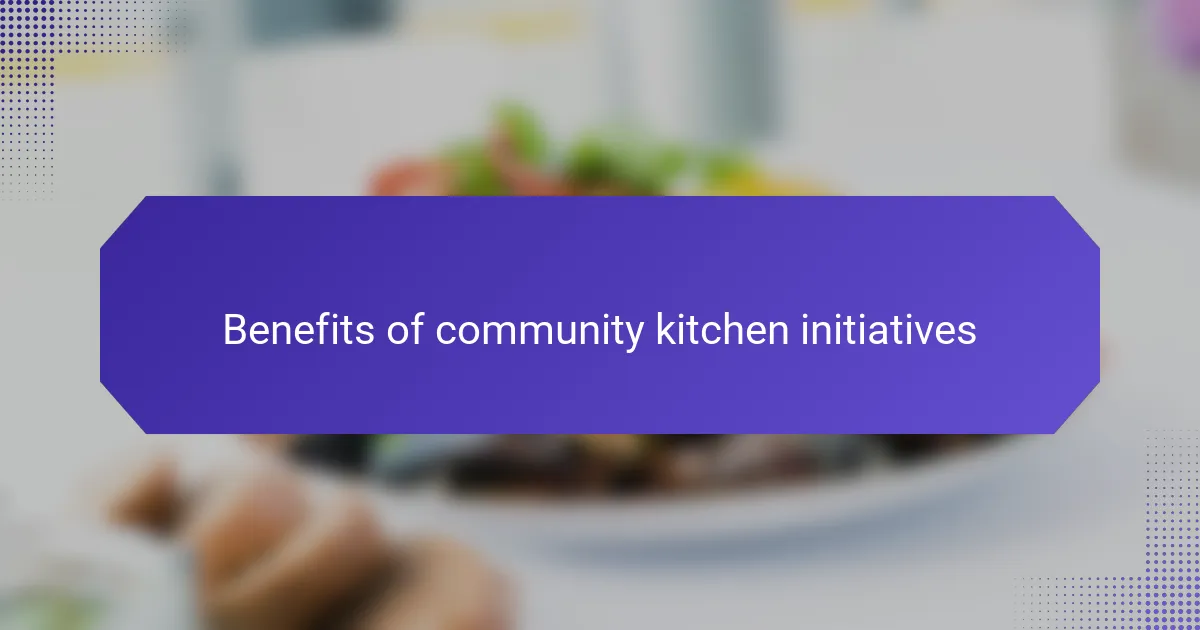Key takeaways
- Community kitchens foster connections, teamwork, and social engagement among diverse individuals while providing access to nutritious meals.
- Cooking challenges promote creativity and resourcefulness, turning food preparation into a communal, enjoyable experience.
- Successful culinary initiatives rely on organization, high-quality ingredients, and a welcoming atmosphere to enhance participation and community bonds.
- Creating recipes for community kitchens should focus on budget-friendly, scalable meals that cater to various dietary needs.

Definition of community kitchens
Community kitchens, often known as collaborative kitchens or shared-use kitchens, are spaces where individuals come together to prepare meals, share resources, and connect with one another. From my observation, these kitchens not only provide access to affordable cooking facilities but also foster a sense of belonging among participants. It’s heartwarming to see people from diverse backgrounds unite with a common goal: nourishing both themselves and their community.
Membership in such initiatives can vary, but what binds all community kitchens is the spirit of teamwork and generosity. I recall visiting a local community kitchen where volunteers transformed donated ingredients into hearty meals for those in need. The laughter, shared recipes, and joyous atmosphere created a profound sense of connection, underscoring the real impact these initiatives can have on individuals and families alike.
| Feature | Community Kitchens |
|---|---|
| Purpose | Provide access to cooking facilities and promote community engagement. |
| Benefits | Access to affordable meals, skill-building, and social interaction. |
| Participants | Anyone interested in cooking and community support, regardless of skill level. |

Benefits of community kitchen initiatives
Community kitchen initiatives offer numerous benefits that extend far beyond just providing meals. From my experience volunteering at one, I’ve seen firsthand the power of these kitchens to forge connections among people. Participants not only enjoy nourishing food but also cultivate friendships and support networks. There’s something special about cooking together; it transforms a simple task into a communal activity filled with laughter and shared stories.
Moreover, community kitchens often focus on sustainability, utilizing local produce and reducing food waste. This not only helps the environment but also educates participants about healthier eating habits. I remember a time when we prepared a meal using surplus vegetables. It was heartening to see everyone’s excitement as we created delicious dishes that might have otherwise gone to waste.
Here are some key benefits of community kitchen initiatives:
- Social Interaction: They create a space where people can meet and connect, fostering a sense of belonging.
- Skill Development: Participants can enhance their cooking skills and learn new techniques.
- Improved Nutrition: Community kitchens often emphasize nutritious meals, promoting healthier eating habits.
- Reduced Food Waste: By utilizing surplus food, these initiatives help minimize waste in the community.
- Empowerment: Involvement in such programs can boost confidence and self-esteem, empowering individuals to make healthier choices.

Overview of cooking challenge recipes
Cooking challenge recipes are an exciting way to bring people together in the kitchen while encouraging creativity and skill. I often find myself engaging in friendly cooking competitions with friends, where we swap secret ingredients or impose quirky rules. Doesn’t it feel satisfying to push your culinary boundaries while having fun together? These challenges not only elevate the cooking experience but also foster camaraderie and laughter among participants.
In my experience, cooking challenges can take many forms, from timed contests to themed recipe battles. I remember a memorable evening when we decided to make meals based solely on the colors in the rainbow. The lively energy in the kitchen was infectious, and seeing our colorful dishes come together was a delightful reward. This aspect of cooking challenges often leads to unique dishes and unforgettable memories.
Moreover, cooking challenge recipes can inspire individuals to experiment with flavors and techniques they might not typically try. I vividly recall attempting a dish I had never heard of, and the thrill of figuring it out step by step only made the end result even more gratifying. Isn’t it amazing how a little challenge in the kitchen can spark newfound passion and creativity in cooking?

Popular cooking challenges to try
When you think about popular cooking challenges, one that comes to mind is the ever-fun “Mystery Box Challenge.” Participants receive a box of ingredients, often unexpected, and must create a dish using only those items. I remember the first time I attempted this with friends—it was both exhilarating and slightly chaotic! The nervous laughter and the desperate brainstorming led to some surprisingly delicious results. Can you imagine the creativity that flows when you have to whip up something fantastic on the spot? It’s like a culinary game that tests your skills while bringing everyone together.
Another exciting challenge is the “One-Pot Meal Challenge,” where the goal is to create a complete meal using just one pot. I once joined a group where we turned this into a friendly competition; the tension mixed with excitement was palpable as we raced against the clock. I discovered that simplicity often leads to the most comforting dishes. The shared experience of cooking, and later enjoying the meal together, really made it special, reinforcing how cooking challenges can turn meals into lasting memories.
Lastly, there’s the “Around the World in 80 Dishes” challenge, where participants pick a country and create a dish that represents its cuisine. I had a blast when my friends and I did this over a weekend. It was fascinating to learn about different cultures and flavors—and trust me, there’s nothing quite like savoring homemade dumplings or enchiladas crafted with love and enthusiasm. Have you ever wondered how food can bridge cultures? These challenges showcase how culinary exploration can broaden our horizons and deepen our understanding of the world through taste.

Creating recipes for community kitchens
Creating recipes for community kitchens is a rewarding experience that allows for creativity while addressing the needs of those less fortunate. I remember the satisfaction I felt when I developed a hearty soup recipe that not only fed a crowd but also brought warmth to those who needed it most. It’s incredible to see how simple ingredients can create comfort and nourishment for people in challenging situations.
When crafting recipes for community kitchens, consider the following tips to ensure that meals are both nutritious and accessible:
- Use budget-friendly ingredients that are easy to source.
- Prioritize recipes that can be scaled up, like casseroles or stews.
- Incorporate a variety of vegetables and proteins to maximize nutrition.
- Include easy-to-follow cooking instructions for volunteers of all skill levels.
- Aim for dishes that are suitable for various dietary needs, like vegetarian or gluten-free options.

Personal experiences with cooking challenges
Personal experiences with cooking challenges have always been a source of joy and growth for me. I recall one community kitchen initiative where we were tasked with creating meals from surplus ingredients. It was challenging, but it pushed my creativity and problem-solving skills to the limit. The sense of camaraderie among participants, as we shared tips and tasted each other’s creations, was truly heartwarming.
Reflecting on that experience, I realized how cooking challenges not only foster individual skills but also build a sense of community. We all had different backgrounds and culinary experiences, yet we came together with the common goal of reducing food waste, and that felt incredibly rewarding.
I often find that cooking challenges can be a bit daunting at first, but once you dive in, it becomes an adventure. The excitement of trying new recipes and techniques while working with others creates lasting memories and friendships.
| Cooking Challenge | Community Kitchen Initiative |
|---|---|
| Focus on individual growth | Emphasis on teamwork and collaboration |
| Personal creativity | Resourcefulness with surplus ingredients |
| Competitive aspect | Supportive environment |

Tips for successful cooking initiatives
When it comes to successful cooking initiatives in community kitchens, organization is key. I’ve found that having a clear plan with assigned roles makes all the difference. For instance, when I participated in a local community event, we designated a head chef, prep cooks, and clean-up crew. This teamwork brought a sense of camaraderie, and we ended up creating delicious meals while enjoying each other’s company.
Another crucial aspect is sourcing quality ingredients. I’ve learned that collaborating with local farmers and markets not only supports the community but also enhances the meals we prepare. In one of my experiences, we received fresh vegetables from a nearby farm, which truly elevated the dishes and made everyone feel good about supporting sustainable practices.
Lastly, creating an inviting atmosphere can encourage participation and engagement. Simple touches, like playing music or decorating the space, can transform a basic cooking setting into a warm and friendly gathering. When I saw participants laughing and bonding over Bolognese sauce, it reinforced the idea that cooking together can nourish both body and soul.
| Key Factor | Importance |
|---|---|
| Organization | Ensures roles are clear and tasks are managed efficiently. |
| Quality Ingredients | Enhances the overall taste and promotes local support. |
| Inviting Atmosphere | Encourages participation and strengthens community bonds. |


